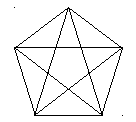Загрузить PDF
Загрузить PDF
Последовательность Фибоначчи – это ряд чисел, в котором каждое последующее число равно сумме двух предыдущих чисел. Числовые последовательности часто встречаются в природе и искусстве в виде спиралей и «золотого сечения». Самый простой способ вычислить последовательность Фибоначчи – это создать таблицу, но такой метод не применим к большим последовательностям. Например, если нужно определить 100-й член последовательности, лучше воспользоваться формулой Бине.
-
1
Нарисуйте таблицу с двумя столбцами. Количество строк таблицы зависит от количества чисел последовательности Фибоначчи, которые нужно найти.
- Например, если нужно найти пятое число последовательности, нарисуйте таблицу с пятью строками.
- Используя таблицу, нельзя найти некоторое случайное число без вычисления всех предыдущих чисел. Например, если нужно найти 100-е число последовательности, нужно вычислить все числа: от первого до 99-ого. Поэтому таблица применима только для нахождения первых чисел последовательности.
-
2
В левом столбце напишите порядковые номера членов последовательности. То есть напишите цифры по порядку, начиная с единицы.
- Такие цифры определяют порядковые номера членов (чисел) последовательности Фибоначчи.
- Например, если нужно найти пятое число последовательности, в левой колонке напишите следующие цифры: 1, 2, 3, 4, 5. То есть нужно найти с первого по пятое число последовательности.
-
3
В первой строке правой колонки напишите 1. Это первое число (член) последовательности Фибоначчи.
- Имейте в виду, что последовательность Фибоначчи всегда начинается с 1. Если последовательность начинается с другого числа, вы неправильно вычислили все числа вплоть до первого.
-
4
К первому члену (1) прибавьте 0. Получится второе число последовательности.
- Запомните: чтобы найти любое число последовательности Фибоначчи, просто сложите два предыдущих числа.
- Чтобы создать последовательность, не забудьте о 0, который стоит перед 1 (первым членом), поэтому 1 + 0 = 1.
-
5
Сложите первый (1) и второй (1) члены. Получится третье число последовательности.
- 1 + 1 = 2. Третий член равен 2.
-
6
Сложите второй (1) и третий (2) члены, чтобы получить четвертое число последовательности.
- 1 + 2 = 3. Четвертый член равен 3.
-
7
Сложите третий (2) и четвертый (3) члены. Получится пятое число последовательности.
- 2 + 3 = 5. Пятый член равен 5.
-
8
Сложите два предыдущих числа, чтобы найти любое число последовательности Фибоначчи. Этот метод основан на формуле:
.[1]
Эта формула не является замкнутой, поэтому при помощи этой формулы нельзя найти любой член последовательности без вычисления всех предыдущих чисел.Реклама
-
1
-
2
В формулу подставьте порядковый номер числа (вместо
).
– это порядковый номер любого искомого члена последовательности.
-
3
В формулу подставьте золотое сечение. Золотое сечение приблизительно равно 1,618034; подставьте в формулу это число.[5]
-
4
Вычислите выражение в скобках. Не забывайте про правильный порядок выполнения математических операций, в котором выражение в скобках вычисляется в первую очередь:
.
-
5
Возведите числа в степени. Возведите в соответствующие степени два числа, которые находятся в числителе.
-
6
Вычтите два числа. Перед тем как приступить к делению, вычтите числа, которые находятся в числителе.
-
7
Полученный результат разделите на квадратный корень из 5. Квадратный корень из 5 приблизительно равен 2,236067.
- В нашем примере:
.
- В нашем примере:
-
8
Полученный результат округлите до ближайшего целого числа. Последний результат будет десятичной дробью, которая близка к целому числу. Такое целое число представляет собой число последовательности Фибоначчи.
- Если в вычислениях использовать неокругленные числа, вы получите целое число. Работать с округленными числами намного легче, но в этом случае вы получите десятичную дробь.[6]
- В нашем примере вы получили десятичную дробь 5,000002. Округлите ее до ближайшего целого числа и получите пятое число последовательности Фибоначчи, которое равно 5.
Реклама
- Если в вычислениях использовать неокругленные числа, вы получите целое число. Работать с округленными числами намного легче, но в этом случае вы получите десятичную дробь.[6]
Об этой статье
Эту страницу просматривали 27 790 раз.
Была ли эта статья полезной?
Журнал
Числа Фибоначчи
Альпина нон-фикшн
+1
Сохранить в закладки
28773
86
Сохранить в закладки
Отрывок из книги математика Эдварда Шейнермана о нестандартной математике, укладке домино и закономерности числовой последовательности
24.07.2018
Над материалом работали

Альпина нон-фикшн
Издательство, специализирующееся на российской и зарубежной научно-популярной литературе

Эдвард Шейнерман
профессор прикладной математики и статистики в Университете Джонса Хопкинса, заместитель декана по высшему образованию в инженерной школе

Добавить в закладки
Вы сможете увидеть эту публикацию в личном кабинете
ПРОМО Вы нужны нам: как поддержать ПостНауку

Добавить в закладки
Вы сможете увидеть эту публикацию в личном кабинете
talks Михаил Спасенных: «Полностью заменить нефть и газ пока нечем»

Добавить в закладки
Вы сможете увидеть эту публикацию в личном кабинете
Видео
3465
Сильные поля в квантовой теории поля

Добавить в закладки
Вы сможете увидеть эту публикацию в личном кабинете
tv Перспективы: Внегалактическая астрономия

Добавить в закладки
Вы сможете увидеть эту публикацию в личном кабинете
FAQ FAQ: Графен

Добавить в закладки
Вы сможете увидеть эту публикацию в личном кабинете
Видео
85649
Материя и антиматерия во Вселенной

Добавить в закладки
Вы сможете увидеть эту публикацию в личном кабинете
FAQ Кассиопея A

Добавить в закладки
Вы сможете увидеть эту публикацию в личном кабинете
Видео
41998
659
Ускорители частиц

Добавить в закладки
Вы сможете увидеть эту публикацию в личном кабинете
Видео
2721
Первые звезды и галактики
-
Задача Фибоначчи
Итальянский
математик Леонардо Фибоначчи жил в 13
столетии и одним из первых в Европе
стал использовать арабские (индийские)
цифры. Он придумал несколько искусственную
задачу о кроликах, которых выращивают
на ферме, причем все они считаются
самками, самцы игнорируются. Кролики
начинают размножаться после того, как
им исполняется два месяца, а потом каждый
месяц рожают по кролику. Кролики никогда
не умирают.
Нужно
определить, сколько кроликов будет на
ферме через n
месяцев, если в начальный момент времени
был только один новорожденный кролик.
Очевидно, что
фермер имеет одного кролика в первый
месяц и одного кролика – во второй
месяц. На третий месяц будет уже два
кролика, на четвертый – три и т.д.
Обозначим количество кроликов в n
месяце как
.
Таким образом,,
,
,
,
,
…
Можно построить
алгоритм, позволяющий найти
при любомn.
Согласно условию
задачи общее количество кроликов
вn+1
месяце раскладывается на три составляющие:
-
одномесячные
кролики, не способные к размножению, в
количестве
;
-
кролики, способные
к размножению, в количестве
;
-
новорожденные
кролики, их количество также равно
.
Таким образом,
получим
. (8.1)
Формула (8.1)
позволяет вычислить ряд чисел: 0, 1, 1, 2,
3, 5, 8, 13, 21, 34, 55, 89, 144, 233, 377, 610, 987, 1597, …
Числа в данной
последовательности называются числами
Фибоначчи.
Если
принять
и
,
то с помощью формулы (8.1) можно определить
все остальные числа Фибоначчи. Формула
(8.1) называется рекуррентной
формулой (recurrence
– «возвращение» на латыни).
Пример 8.1.
Предположим,
что имеется лестница в n
ступенек. Мы можем подниматься по ней
с шагом в одну ступеньку, либо – с шагом
в две ступеньки. Сколько существует
комбинаций различных способов подъема?
Если
n
= 1, имеется только один вариант решения
задачи. Для n
= 2 существует 2 варианта: два единичных
шага либо один двойной. Для n
= 3 существует 3 варианта: три единичных
шага, либо один единичный и один двойной,
либо один двойной и один единичный.
В
следующем случае n
= 4, имеем 5 возможностей (1+1+1+1, 2+1+1, 1+2+1,
1+1+2, 2+2).
Для
того чтобы ответить на заданный вопрос
при произвольном n,
обозначим количество вариантов как
,
и попробуем определитьпо известным
и
.
Если мы стартуем с единичного шага, то
имеем
комбинаций для оставшихсяn
ступенек. Если стартуем с двойного шага,
то имеем
комбинаций для оставшихсяn–1
ступенек. Общее количество вариантов
для n+1
ступенек равно
. (8.2)
Полученная
формула как близнец напоминает формулу
(8.1). Тем не менее, это не позволяет
отождествлять количество комбинаций
с числами Фибоначчи
.
Мы видим, например, что,
но.
Однако имеет место следующая зависимость:
.
Это
справедливо для n
= 1, 2, и также справедливо для каждого n.
Числа Фибоначчи и количество комбинаций
вычисляются по одной и той же формуле,
однако начальные значения,
и
,
у них различаются.
Пример 8.2. Этот
пример имеет
практическое
значение для задач помехоустойчивого
кодирования. Найдем число всех двоичных
слов длины n,
не содержащих несколько нулей подряд.
Обозначим это число через
.
Очевидно,,
а слова длины 2, удовлетворяющие нашему
ограничению, таковы: 10, 01, 11, т.е..
Пусть– такое слово изn
символов. Если символ
,
томожет быть произвольным (
)-буквенным
словом, не содержащим несколько нулей
подряд. Значит, число слов с единицей
на конце равно.
Если же символ
,
то обязательно,
а первыесимвола
могут быть произвольными с учетом
рассматриваемых ограничений. Следовательно,
имеетсяслов длины
n
с нулем на конце. Таким образом, общее
число интересующих нас слов равно
.
С учетом того, что
и
,
полученная последовательность чисел
– это числа Фибоначчи.
Пример 8.3. В
примере 7.6 мы нашли, что число двоичных
слов постоянного веса t
(и длиной k)
равно
.
Теперь найдем число двоичных слов
постоянного весаt,
не содержащих несколько нулей подряд.
Рассуждать можно
так. Пусть
число нулей в рассматриваемых словах.
В любом слове имеетсяпромежутков между ближайшими нулями,
в каждом из которых находится одна или
несколько единиц. Предполагается, что.
В противном случае нет ни одного слова
без рядом стоящих нулей.
Если из каждого
промежутка удалить ровно по одной
единице, то получим слово длины
,
содержащеенулей. Любое такое слово может быть
получено указанным образом из некоторого
(и притом только одного)k-буквенного
слова, содержащего
нулей, никакие два из которых не стоят
рядом. Значит, искомое число совпадает
с числом всех слов длины,
содержащих ровнонулей, т.е. равно
.
Пример 8.4. Докажем,
что сумма
равна числам Фибоначчи для любого целого
.
Символобозначаетнаименьшее
целое число, большее или равное
.
Например, если,
то;
а если,
то.
По-английски эту операцию называютceil
(«потолок»). Также встречается символ
,
который обозначаетнаибольшее
целое число, меньшее или равное
.
По-английски эту операцию называютfloor
(«пол»).
Если
,
то.
Если,
то.
Если,
то.
Таким образом, для
рассмотренных случаев сумма действительно
равна числам Фибоначчи. Теперь приведем
доказательство для общего случая.
Поскольку числа Фибоначчи можно получить
с помощью рекуррентного уравнения
(8.1), то должно выполняться равенство:
.
И оно действительно
выполняется:
Здесь мы использовали
полученную ранее формулу (4.4):
.
-
Сумма чисел
Фибоначчи
Определим
сумму первых n
чисел Фибоначчи.
0 = 0,
0+1 = 1,
0+1+1 = 2,
0+1+1+2 = 4,
0+1+1+2+3 = 7,
0+1+1+2+3+5 = 12,
0+1+1+2+3+5+8 = 20,
0+1+1+2+3+5+8+13 = 33.
Легко
заметить, что прибавлением к правой
части каждого уравнения единицы мы
снова получаем число Фибоначчи. Общая
формула для определения суммы первых
n
чисел Фибоначчи имеет вид:
.
Докажем это,
используя метод математической индукции.
Для этого запишем:
.
Эта
сумма должна быть равна
.
.
Сократив левую и
правую часть уравнения на –1, получим
уравнение (6.1).
-
Формула для
чисел Фибоначчи
Теорема
8.1.
Числа
Фибоначчи можно рассчитать по формуле
.
Доказательство.
Убедимся в справедливости этой формулы
для n
= 0, 1, а затем докажем справедливость
данной формулы для произвольного n
по индукции. Вычислим отношение двух
ближайших чисел Фибоначчи:
Мы
видим, что отношение этих чисел колеблется
около значения 1.618 (если игнорировать
несколько первых значений). Этим свойством
числа Фибоначчи напоминают члены
геометрической прогрессии. Примем
,
().
Тогда выражение
преобразуется в
,
которое после
упрощений выглядит так
.
Мы
получили квадратное уравнение, корни
которого равны:
Теперь
можем записать:
(где
c
является константой). Оба члена
и
не дают чисел Фибоначчи,
например
,
в то время как.
Однако разность
удовлетворяет
рекуррентному уравнению:
.
Для
n=0
эта разность дает,
то есть: .
Однако при n=1
мы имеем .
Чтобы получить
,
необходимо принять:.
Теперь
мы имеем две последовательности:
и ,
которые начинаются с одинаковых двух
чисел и удовлетворяют одной и той же
рекуррентной формуле. Они должны быть
равны: .
Теорема доказана.
При
возрастании n
член
становится очень большим, в то время
как,
и роль членав разности сокращается.
Поэтому при больших n
приближенно можем записать
.
Мы
игнорируем 1/2 (поскольку числа Фибоначчи
возрастают до бесконечности при росте
n
до бесконечности).
Отношение
называется золотым
сечением,
его используют за пределами математики
(например, в скульптуре и архитектуре).
Золотым сечением является отношение
между диагональю и стороной правильного
пятиугольника
(рис. 8.1).
Рис.
8.1. Правильный пятиугольник и его
диагонали
Для обозначения
золотого сечения принято использовать
букву
в честь известного афинского скульптора
Фидия.
-
Простые числа
Все натуральные
числа, большие единицы, распадаются на
два класса. К первому относятся числа,
имеющие ровно два натуральных делителя,
единицу и самого себя, ко второму – все
остальные. Числа первого класса называют
простыми,
а второго – составными.
Простые числа в пределах первых трех
десятков: 2, 3, 5, 7, 11, 13, 17, 19, 23, 29, …
Свойства простых
чисел и их связь со всеми натуральными
числами изучалась Евклидом (3 век до
нашей эры). Если выписывать простые
числа подряд, то можно заметить, что
относительная плотность их убывает. На
первый десяток их приходится 4, т. е. 40%,
на сотню – 25, т.е. 25%, на тысячу – 168, т.е.
меньше 17%, на миллион – 78498, т.е. меньше
8%, и т.д.. Тем не менее, их общее число
бесконечно.
Среди простых
чисел попадаются пары таких, разность
между которыми равна двум (так называемые
простые
близнецы),
однако конечность или бесконечность
таких пар не доказана.
Евклид считал
очевидным, что с помощью умножения
только простых чисел можно получить
все натуральные числа, причем каждое
натуральное число представимо в виде
произведения простых чисел единственным
образом (с точностью до порядка
множителей). Таким образом, простые
числа образуют мультипликативный базис
натурального ряда.
Изучение распределения
простых чисел привело к созданию
алгоритма, позволяющего получать таблицы
простых чисел. Таким алгоритмом является
решето
Эратосфена
(3 век до нашей эры). Этот метод заключается
в отсеивании (например, путем зачеркивания)
тех целых чисел заданной последовательности
,
которые делятся хотя бы на одно из
простых чисел, меньших.
Теорема
8.2.
(теорема Евклида).
Число
простых чисел бесконечно.
Доказательство.
Теорему
Евклида о бесконечности числа простых
чисел докажем способом, предложенным
Леонардом Эйлером (1707–1783). Эйлер
рассмотрел произведение по всем простым
числам p:
при
.
Это произведение сходится, и если его
раскрыть, то в силу однозначности
разложения натуральных чисел на простые
сомножители получается, что оно равняется
сумме ряда,
откуда следует тождество Эйлера:
.
Так как при
ряд справа расходится (гармонический
ряд), то из тождества Эйлера следует
теорема Евклида.
Русский математик
П.Л. Чебышев (1821–1894) вывел формулу,
определяющую пределы, в которых заключено
число простых чисел
,
не превосходящихX:
,
где
,
.
A tiling with squares whose side lengths are successive Fibonacci numbers: 1, 1, 2, 3, 5, 8, 13 and 21.
In mathematics, the Fibonacci sequence is a sequence in which each number is the sum of the two preceding ones. Numbers that are part of the Fibonacci sequence are known as Fibonacci numbers, commonly denoted Fn . The sequence commonly starts from 0 and 1, although some authors start the sequence from 1 and 1 or sometimes (as did Fibonacci) from 1 and 2. Starting from 0 and 1, the first few values in the sequence are:[1]
- 0, 1, 1, 2, 3, 5, 8, 13, 21, 34, 55, 89, 144.
The Fibonacci numbers were first described in Indian mathematics,[2][3][4] as early as 200 BC in work by Pingala on enumerating possible patterns of Sanskrit poetry formed from syllables of two lengths. They are named after the Italian mathematician Leonardo of Pisa, also known as Fibonacci, who introduced the sequence to Western European mathematics in his 1202 book Liber Abaci.[5]
Fibonacci numbers appear unexpectedly often in mathematics, so much so that there is an entire journal dedicated to their study, the Fibonacci Quarterly. Applications of Fibonacci numbers include computer algorithms such as the Fibonacci search technique and the Fibonacci heap data structure, and graphs called Fibonacci cubes used for interconnecting parallel and distributed systems. They also appear in biological settings, such as branching in trees, the arrangement of leaves on a stem, the fruit sprouts of a pineapple, the flowering of an artichoke, an uncurling fern, and the arrangement of a pine cone’s bracts.
Fibonacci numbers are also strongly related to the golden ratio: Binet’s formula expresses the nth Fibonacci number in terms of n and the golden ratio, and implies that the ratio of two consecutive Fibonacci numbers tends to the golden ratio as n increases. Fibonacci numbers are also closely related to Lucas numbers, which obey the same recurrence relation and with the Fibonacci numbers form a complementary pair of Lucas sequences.
Definition[edit]
The Fibonacci spiral: an approximation of the golden spiral created by drawing circular arcs connecting the opposite corners of squares in the Fibonacci tiling; (see preceding image)
The Fibonacci numbers may be defined by the recurrence relation[6]
and
for n > 1.
Under some older definitions, the value 


The first 20 Fibonacci numbers Fn are:[1]
-
F0 F1 F2 F3 F4 F5 F6 F7 F8 F9 F10 F11 F12 F13 F14 F15 F16 F17 F18 F19 0 1 1 2 3 5 8 13 21 34 55 89 144 233 377 610 987 1597 2584 4181
History[edit]
India[edit]
Thirteen (F7) ways of arranging long and short syllables in a cadence of length six. Eight (F6) end with a short syllable and five (F5) end with a long syllable.
The Fibonacci sequence appears in Indian mathematics, in connection with Sanskrit prosody.[3][9][10] In the Sanskrit poetic tradition, there was interest in enumerating all patterns of long (L) syllables of 2 units duration, juxtaposed with short (S) syllables of 1 unit duration. Counting the different patterns of successive L and S with a given total duration results in the Fibonacci numbers: the number of patterns of duration m units is Fm+1.[4]
Knowledge of the Fibonacci sequence was expressed as early as Pingala (c. 450 BC–200 BC). Singh cites Pingala’s cryptic formula misrau cha («the two are mixed») and scholars who interpret it in context as saying that the number of patterns for m beats (Fm+1) is obtained by adding one [S] to the Fm cases and one [L] to the Fm−1 cases.[11] Bharata Muni also expresses knowledge of the sequence in the Natya Shastra (c. 100 BC–c. 350 AD).[12][2]
However, the clearest exposition of the sequence arises in the work of Virahanka (c. 700 AD), whose own work is lost, but is available in a quotation by Gopala (c. 1135):[10]
Variations of two earlier meters [is the variation]… For example, for [a meter of length] four, variations of meters of two [and] three being mixed, five happens. [works out examples 8, 13, 21]… In this way, the process should be followed in all mātrā-vṛttas [prosodic combinations].[a]
Hemachandra (c. 1150) is credited with knowledge of the sequence as well,[2] writing that «the sum of the last and the one before the last is the number … of the next mātrā-vṛtta.»[14][15]
Europe[edit]
A page of Fibonacci’s Liber Abaci from the Biblioteca Nazionale di Firenze showing (in box on right) 13 entries of the Fibonacci sequence:
the indices from present to XII (months) as Latin ordinals and Roman numerals and the numbers (of rabbit pairs) as Hindu-Arabic numerals starting with 1, 2, 3, 5 and ending with 377.
The Fibonacci sequence first appears in the book Liber Abaci (The Book of Calculation, 1202) by Fibonacci[16][17] where it is used to calculate the growth of rabbit populations.[18][19] Fibonacci considers the growth of an idealized (biologically unrealistic) rabbit population, assuming that: a newly born breeding pair of rabbits are put in a field; each breeding pair mates at the age of one month, and at the end of their second month they always produce another pair of rabbits; and rabbits never die, but continue breeding forever. Fibonacci posed the puzzle: how many pairs will there be in one year?
- At the end of the first month, they mate, but there is still only 1 pair.
- At the end of the second month they produce a new pair, so there are 2 pairs in the field.
- At the end of the third month, the original pair produce a second pair, but the second pair only mate to gestate for a month, so there are 3 pairs in all.
- At the end of the fourth month, the original pair has produced yet another new pair, and the pair born two months ago also produces their first pair, making 5 pairs.
At the end of the nth month, the number of pairs of rabbits is equal to the number of mature pairs (that is, the number of pairs in month n – 2) plus the number of pairs alive last month (month n – 1). The number in the nth month is the nth Fibonacci number.[20]
The name «Fibonacci sequence» was first used by the 19th-century number theorist Édouard Lucas.[21]
In a growing idealized population, the number of rabbit pairs form the Fibonacci sequence. At the end of the nth month, the number of pairs is equal to Fn.
Relation to the golden ratio[edit]
Closed-form expression[edit]
Like every sequence defined by a linear recurrence with constant coefficients, the Fibonacci numbers have a closed-form expression. It has become known as Binet’s formula, named after French mathematician Jacques Philippe Marie Binet, though it was already known by Abraham de Moivre and Daniel Bernoulli:[22]
where
is the golden ratio, and ψ is its conjugate:[23]
Since 
To see the relation between the sequence and these constants,[24] note that φ and ψ are both solutions of the equation 

It follows that for any values a and b, the sequence defined by
satisfies the same recurrence,
If a and b are chosen so that U0 = 0 and U1 = 1 then the resulting sequence Un must be the Fibonacci sequence. This is the same as requiring a and b satisfy the system of equations:
which has solution
producing the required formula.
Taking the starting values U0 and U1 to be arbitrary constants, a more general solution is:
where
Computation by rounding[edit]
Since


In fact, the rounding error is very small, being less than 0.1 for n ≥ 4, and less than 0.01 for n ≥ 8. This formula is easily inverted to find an index of a Fibonacci number F:
Instead using the floor function gives the largest index of a Fibonacci number that is not greater than F:
where 


Magnitude[edit]
Since Fn is asymptotic to 

More generally, in the base b representation, the number of digits in Fn is asymptotic to 
Limit of consecutive quotients[edit]
Johannes Kepler observed that the ratio of consecutive Fibonacci numbers converges. He wrote that «as 5 is to 8 so is 8 to 13, practically, and as 8 is to 13, so is 13 to 21 almost», and concluded that these ratios approach the golden ratio 
This convergence holds regardless of the starting values 


In general, 

-
Successive tilings of the plane and a graph of approximations to the golden ratio calculated by dividing each Fibonacci number by the previous
Decomposition of powers[edit]
Since the golden ratio satisfies the equation
this expression can be used to decompose higher powers 

This equation can be proved by induction on n ≥ 1:
For 

These expressions are also true for n < 1 if the Fibonacci sequence Fn is extended to negative integers using the Fibonacci rule 
Identification[edit]
Binet’s formula provides a proof that a positive integer x is a Fibonacci number if and only if at least one of 




Comparing this to 
In particular, the left-hand side is a perfect square.
Matrix form[edit]
A 2-dimensional system of linear difference equations that describes the Fibonacci sequence is
alternatively denoted
which yields 


and
As the initial value is
it follows that the nth term is
From this, the nth element in the Fibonacci series
may be read off directly as a closed-form expression:
Equivalently, the same computation may be performed by diagonalization of A through use of its eigendecomposition:
where 
The closed-form expression for the nth element in the Fibonacci series is therefore given by
which again yields
The matrix A has a determinant of −1, and thus it is a 2 × 2 unimodular matrix.
This property can be understood in terms of the continued fraction representation for the golden ratio:
The Fibonacci numbers occur as the ratio of successive convergents of the continued fraction for φ, and the matrix formed from successive convergents of any continued fraction has a determinant of +1 or −1. The matrix representation gives the following closed-form expression for the Fibonacci numbers:
For a given n, this matrix can be computed in O(log(n)) arithmetic operations, using the exponentiation by squaring method.
Taking the determinant of both sides of this equation yields Cassini’s identity,
Moreover, since AnAm = An+m for any square matrix A, the following identities can be derived (they are obtained from two different coefficients of the matrix product, and one may easily deduce the second one from the first one by changing n into n + 1),
In particular, with m = n,
These last two identities provide a way to compute Fibonacci numbers recursively in O(log(n)) arithmetic operations and in time O(M(n) log(n)), where M(n) is the time for the multiplication of two numbers of n digits. This matches the time for computing the nth Fibonacci number from the closed-form matrix formula, but with fewer redundant steps if one avoids recomputing an already computed Fibonacci number (recursion with memoization).[30]
Combinatorial identities[edit]
Combinatorial proofs[edit]
Most identities involving Fibonacci numbers can be proved using combinatorial arguments using the fact that 





In this manner the recurrence relation
may be understood by dividing the 
Excluding the first element, the remaining terms in each sequence sum to 





In a similar manner it may be shown that the sum of the first Fibonacci numbers up to the nth is equal to the (n + 2)nd Fibonacci number minus 1.[31] In symbols:
This may be seen by dividing all sequences summing to 


Following the same logic as before, by summing the cardinality of each set we see that
… where the last two terms have the value 

A similar argument, grouping the sums by the position of the first 1 rather than the first 2 gives two more identities:
and
In words, the sum of the first Fibonacci numbers with odd index up to 

A different trick may be used to prove
or in words, the sum of the squares of the first Fibonacci numbers up to 



Symbolic method[edit]
The sequence 



It follows that the ordinary generating function of the Fibonacci sequence, 

Induction proofs[edit]
Fibonacci identities often can be easily proved using mathematical induction.
For example, reconsider
Adding 
and so we have the formula for 
Similarly, add 
to give
Binet formula proofs[edit]
The Binet formula is
This can be used to prove Fibonacci identities.
For example, to prove that
note that the left hand side multiplied by 
as required, using the facts 

Other identities[edit]
Numerous other identities can be derived using various methods. Here are some of them:[34]
Cassini’s and Catalan’s identities[edit]
Cassini’s identity states that
Catalan’s identity is a generalization:
d’Ocagne’s identity[edit]
where Ln is the n-th Lucas number. The last is an identity for doubling n; other identities of this type are
by Cassini’s identity.
These can be found experimentally using lattice reduction, and are useful in setting up the special number field sieve to factorize a Fibonacci number.
More generally,[34]
or alternatively
Putting k = 2 in this formula, one gets again the formulas of the end of above section Matrix form.
Generating function[edit]
The generating function of the Fibonacci sequence is the power series
This series is convergent for any complex number 

This can be proved by multiplying by 
where all terms involving 

The partial fraction decomposition is given by
where 

The related function 

Reciprocal sums[edit]
Infinite sums over reciprocal Fibonacci numbers can sometimes be evaluated in terms of theta functions. For example, the sum of every odd-indexed reciprocal Fibonacci number can be written as
and the sum of squared reciprocal Fibonacci numbers as
If we add 1 to each Fibonacci number in the first sum, there is also the closed form
and there is a nested sum of squared Fibonacci numbers giving the reciprocal of the golden ratio,
The sum of all even-indexed reciprocal Fibonacci numbers is[36]
with the Lambert series 
So the reciprocal Fibonacci constant is[37]
Moreover, this number has been proved irrational by Richard André-Jeannin.[38]
Millin’s series gives the identity[39]
which follows from the closed form for its partial sums as N tends to infinity:
Primes and divisibility[edit]
Divisibility properties[edit]
Every third number of the sequence is even (a multiple of 
where gcd is the greatest common divisor function.
In particular, any three consecutive Fibonacci numbers are pairwise coprime because both 

for every n.
Every prime number p divides a Fibonacci number that can be determined by the value of p modulo 5. If p is congruent to 1 or 4 modulo 5, then p divides Fp−1, and if p is congruent to 2 or 3 modulo 5, then, p divides Fp+1. The remaining case is that p = 5, and in this case p divides Fp.
These cases can be combined into a single, non-piecewise formula, using the Legendre symbol:[42]
Primality testing[edit]
The above formula can be used as a primality test in the sense that if
where the Legendre symbol has been replaced by the Jacobi symbol, then this is evidence that n is a prime, and if it fails to hold, then n is definitely not a prime. If n is composite and satisfies the formula, then n is a Fibonacci pseudoprime. When m is large – say a 500-bit number – then we can calculate Fm (mod n) efficiently using the matrix form. Thus
Here the matrix power Am is calculated using modular exponentiation, which can be adapted to matrices.[43]
Fibonacci primes[edit]
A Fibonacci prime is a Fibonacci number that is prime. The first few are:[44]
- 2, 3, 5, 13, 89, 233, 1597, 28657, 514229, …
Fibonacci primes with thousands of digits have been found, but it is not known whether there are infinitely many.[45]
Fkn is divisible by Fn, so, apart from F4 = 3, any Fibonacci prime must have a prime index. As there are arbitrarily long runs of composite numbers, there are therefore also arbitrarily long runs of composite Fibonacci numbers.
No Fibonacci number greater than F6 = 8 is one greater or one less than a prime number.[46]
The only nontrivial square Fibonacci number is 144.[47] Attila Pethő proved in 2001 that there is only a finite number of perfect power Fibonacci numbers.[48] In 2006, Y. Bugeaud, M. Mignotte, and S. Siksek proved that 8 and 144 are the only such non-trivial perfect powers.[49]
1, 3, 21, and 55 are the only triangular Fibonacci numbers, which was conjectured by Vern Hoggatt and proved by Luo Ming.[50]
No Fibonacci number can be a perfect number.[51] More generally, no Fibonacci number other than 1 can be multiply perfect,[52] and no ratio of two Fibonacci numbers can be perfect.[53]
Prime divisors[edit]
With the exceptions of 1, 8 and 144 (F1 = F2, F6 and F12) every Fibonacci number has a prime factor that is not a factor of any smaller Fibonacci number (Carmichael’s theorem).[54] As a result, 8 and 144 (F6 and F12) are the only Fibonacci numbers that are the product of other Fibonacci numbers.[55]
The divisibility of Fibonacci numbers by a prime p is related to the Legendre symbol 
If p is a prime number then
[56][57]
For example,
It is not known whether there exists a prime p such that
Such primes (if there are any) would be called Wall–Sun–Sun primes.
Also, if p ≠ 5 is an odd prime number then:[58]
Example 1. p = 7, in this case p ≡ 3 (mod 4) and we have:
Example 2. p = 11, in this case p ≡ 3 (mod 4) and we have:
Example 3. p = 13, in this case p ≡ 1 (mod 4) and we have:
Example 4. p = 29, in this case p ≡ 1 (mod 4) and we have:
For odd n, all odd prime divisors of Fn are congruent to 1 modulo 4, implying that all odd divisors of Fn (as the products of odd prime divisors) are congruent to 1 modulo 4.[59]
For example,
All known factors of Fibonacci numbers F(i ) for all i < 50000 are collected at the relevant repositories.[60][61]
Periodicity modulo n[edit]
If the members of the Fibonacci sequence are taken mod n, the resulting sequence is periodic with period at most 6n.[62] The lengths of the periods for various n form the so-called Pisano periods.[63] Determining a general formula for the Pisano periods is an open problem, which includes as a subproblem a special instance of the problem of finding the multiplicative order of a modular integer or of an element in a finite field. However, for any particular n, the Pisano period may be found as an instance of cycle detection.
Generalizations[edit]
The Fibonacci sequence is one of the simplest and earliest known sequences defined by a recurrence relation, and specifically by a linear difference equation. All these sequences may be viewed as generalizations of the Fibonacci sequence. In particular, Binet’s formula may be generalized to any sequence that is a solution of a homogeneous linear difference equation with constant coefficients.
Some specific examples that are close, in some sense, to the Fibonacci sequence include:
- Generalizing the index to negative integers to produce the negafibonacci numbers.
- Generalizing the index to real numbers using a modification of Binet’s formula.[34]
- Starting with other integers. Lucas numbers have L1 = 1, L2 = 3, and Ln = Ln−1 + Ln−2. Primefree sequences use the Fibonacci recursion with other starting points to generate sequences in which all numbers are composite.
- Letting a number be a linear function (other than the sum) of the 2 preceding numbers. The Pell numbers have Pn = 2Pn−1 + Pn−2. If the coefficient of the preceding value is assigned a variable value x, the result is the sequence of Fibonacci polynomials.
- Not adding the immediately preceding numbers. The Padovan sequence and Perrin numbers have P(n) = P(n − 2) + P(n − 3).
- Generating the next number by adding 3 numbers (tribonacci numbers), 4 numbers (tetranacci numbers), or more. The resulting sequences are known as n-Step Fibonacci numbers.[64]
Applications[edit]
Mathematics[edit]
The Fibonacci numbers are the sums of the diagonals (shown in red) of a left-justified Pascal’s triangle.
The Fibonacci numbers occur as the sums of binomial coefficients in the «shallow» diagonals of Pascal’s triangle:[65]
This can be proved by expanding the generating function
and collecting like terms of 
To see how the formula is used, we can arrange the sums by the number of terms present:
-
5 = 1+1+1+1+1 = 2+1+1+1 = 1+2+1+1 = 1+1+2+1 = 1+1+1+2 = 2+2+1 = 2+1+2 = 1+2+2
which is 
Use of the Fibonacci sequence to count {1, 2}-restricted compositions
These numbers also give the solution to certain enumerative problems,[66] the most common of which is that of counting the number of ways of writing a given number n as an ordered sum of 1s and 2s (called compositions); there are Fn+1 ways to do this (equivalently, it’s also the number of domino tilings of the 
-
5 = 1+1+1+1+1 = 2+1+1+1 = 1+2+1+1 = 1+1+2+1 = 2+2+1 = 1+1+1+2 = 2+1+2 = 1+2+2
The figure shows that 8 can be decomposed into 5 (the number of ways to climb 4 steps, followed by a single-step) plus 3 (the number of ways to climb 3 steps, followed by a double-step). The same reasoning is applied recursively until a single step, of which there is only one way to climb.
The Fibonacci numbers can be found in different ways among the set of binary strings, or equivalently, among the subsets of a given set.
- The number of binary strings of length n without consecutive 1s is the Fibonacci number Fn+2. For example, out of the 16 binary strings of length 4, there are F6 = 8 without consecutive 1s – they are 0000, 0001, 0010, 0100, 0101, 1000, 1001, and 1010. Such strings are the binary representations of Fibbinary numbers. Equivalently, Fn+2 is the number of subsets S of {1, …, n} without consecutive integers, that is, those S for which {i, i + 1} ⊈ S for every i. A bijection with the sums to n+1 is to replace 1 with 0 and 2 with 10, and drop the last zero.
- The number of binary strings of length n without an odd number of consecutive 1s is the Fibonacci number Fn+1. For example, out of the 16 binary strings of length 4, there are F5 = 5 without an odd number of consecutive 1s – they are 0000, 0011, 0110, 1100, 1111. Equivalently, the number of subsets S of {1, …, n} without an odd number of consecutive integers is Fn+1. A bijection with the sums to n is to replace 1 with 0 and 2 with 11.
- The number of binary strings of length n without an even number of consecutive 0s or 1s is 2Fn. For example, out of the 16 binary strings of length 4, there are 2F4 = 6 without an even number of consecutive 0s or 1s – they are 0001, 0111, 0101, 1000, 1010, 1110. There is an equivalent statement about subsets.
- Yuri Matiyasevich was able to show that the Fibonacci numbers can be defined by a Diophantine equation, which led to his solving Hilbert’s tenth problem.[67]
- The Fibonacci numbers are also an example of a complete sequence. This means that every positive integer can be written as a sum of Fibonacci numbers, where any one number is used once at most.
- Moreover, every positive integer can be written in a unique way as the sum of one or more distinct Fibonacci numbers in such a way that the sum does not include any two consecutive Fibonacci numbers. This is known as Zeckendorf’s theorem, and a sum of Fibonacci numbers that satisfies these conditions is called a Zeckendorf representation. The Zeckendorf representation of a number can be used to derive its Fibonacci coding.
- Starting with 5, every second Fibonacci number is the length of the hypotenuse of a right triangle with integer sides, or in other words, the largest number in a Pythagorean triple, obtained from the formula
The sequence of Pythagorean triangles obtained from this formula has sides of lengths (3,4,5), (5,12,13), (16,30,34), (39,80,89), … . The middle side of each of these triangles is the sum of the three sides of the preceding triangle.[68]
- The Fibonacci cube is an undirected graph with a Fibonacci number of nodes that has been proposed as a network topology for parallel computing.
- Fibonacci numbers appear in the ring lemma, used to prove connections between the circle packing theorem and conformal maps.[69]
Computer science[edit]
Fibonacci tree of height 6. Balance factors green; heights red.
The keys in the left spine are Fibonacci numbers.
- The Fibonacci numbers are important in computational run-time analysis of Euclid’s algorithm to determine the greatest common divisor of two integers: the worst case input for this algorithm is a pair of consecutive Fibonacci numbers.[70]
- Fibonacci numbers are used in a polyphase version of the merge sort algorithm in which an unsorted list is divided into two lists whose lengths correspond to sequential Fibonacci numbers – by dividing the list so that the two parts have lengths in the approximate proportion φ. A tape-drive implementation of the polyphase merge sort was described in The Art of Computer Programming.
- A Fibonacci tree is a binary tree whose child trees (recursively) differ in height by exactly 1. So it is an AVL tree, and one with the fewest nodes for a given height — the «thinnest» AVL tree. These trees have a number of vertices that is a Fibonacci number minus one, an important fact in the analysis of AVL trees.[71]
- Fibonacci numbers are used by some pseudorandom number generators.
- Fibonacci numbers arise in the analysis of the Fibonacci heap data structure.
- A one-dimensional optimization method, called the Fibonacci search technique, uses Fibonacci numbers.[72]
- The Fibonacci number series is used for optional lossy compression in the IFF 8SVX audio file format used on Amiga computers. The number series compands the original audio wave similar to logarithmic methods such as μ-law.[73][74]
- Some Agile teams use a modified series called the «Modified Fibonacci Series» in planning poker, as an estimation tool. Planning Poker is a formal part of the Scaled Agile Framework.[75]
- Fibonacci coding
- Negafibonacci coding
Nature[edit]
Yellow chamomile head showing the arrangement in 21 (blue) and 13 (cyan) spirals. Such arrangements involving consecutive Fibonacci numbers appear in a wide variety of plants.
Fibonacci sequences appear in biological settings,[76] such as branching in trees, arrangement of leaves on a stem, the fruitlets of a pineapple,[77] the flowering of artichoke, an uncurling fern and the arrangement of a pine cone,[78] and the family tree of honeybees.[79][80] Kepler pointed out the presence of the Fibonacci sequence in nature, using it to explain the (golden ratio-related) pentagonal form of some flowers.[81] Field daisies most often have petals in counts of Fibonacci numbers.[82] In 1830, K. F. Schimper and A. Braun discovered that the parastichies (spiral phyllotaxis) of plants were frequently expressed as fractions involving Fibonacci numbers.[83]
Przemysław Prusinkiewicz advanced the idea that real instances can in part be understood as the expression of certain algebraic constraints on free groups, specifically as certain Lindenmayer grammars.[84]
Illustration of Vogel’s model for n = 1 … 500
A model for the pattern of florets in the head of a sunflower was proposed by Helmut Vogel [de] in 1979.[85] This has the form
where n is the index number of the floret and c is a constant scaling factor; the florets thus lie on Fermat’s spiral. The divergence angle, approximately 137.51°, is the golden angle, dividing the circle in the golden ratio. Because this ratio is irrational, no floret has a neighbor at exactly the same angle from the center, so the florets pack efficiently. Because the rational approximations to the golden ratio are of the form F( j):F( j + 1), the nearest neighbors of floret number n are those at n ± F( j) for some index j, which depends on r, the distance from the center. Sunflowers and similar flowers most commonly have spirals of florets in clockwise and counter-clockwise directions in the amount of adjacent Fibonacci numbers,[86] typically counted by the outermost range of radii.[87]
Fibonacci numbers also appear in the pedigrees of idealized honeybees, according to the following rules:
- If an egg is laid by an unmated female, it hatches a male or drone bee.
- If, however, an egg was fertilized by a male, it hatches a female.
Thus, a male bee always has one parent, and a female bee has two. If one traces the pedigree of any male bee (1 bee), he has 1 parent (1 bee), 2 grandparents, 3 great-grandparents, 5 great-great-grandparents, and so on. This sequence of numbers of parents is the Fibonacci sequence. The number of ancestors at each level, Fn, is the number of female ancestors, which is Fn−1, plus the number of male ancestors, which is Fn−2.[88] This is under the unrealistic assumption that the ancestors at each level are otherwise unrelated.
The number of possible ancestors on the X chromosome inheritance line at a given ancestral generation follows the Fibonacci sequence. (After Hutchison, L. «Growing the Family Tree: The Power of DNA in Reconstructing Family Relationships».[89])
It has been noticed that the number of possible ancestors on the human X chromosome inheritance line at a given ancestral generation also follows the Fibonacci sequence.[89] A male individual has an X chromosome, which he received from his mother, and a Y chromosome, which he received from his father. The male counts as the «origin» of his own X chromosome (




Other[edit]
- In optics, when a beam of light shines at an angle through two stacked transparent plates of different materials of different refractive indexes, it may reflect off three surfaces: the top, middle, and bottom surfaces of the two plates. The number of different beam paths that have k reflections, for k > 1, is the
th Fibonacci number. (However, when k = 1, there are three reflection paths, not two, one for each of the three surfaces.)[90]
- Fibonacci retracement levels are widely used in technical analysis for financial market trading.
- Since the conversion factor 1.609344 for miles to kilometers is close to the golden ratio, the decomposition of distance in miles into a sum of Fibonacci numbers becomes nearly the kilometer sum when the Fibonacci numbers are replaced by their successors. This method amounts to a radix 2 number register in golden ratio base φ being shifted. To convert from kilometers to miles, shift the register down the Fibonacci sequence instead.[91]
- The measured values of voltages and currents in the infinite resistor chain circuit (also called the resistor ladder or infinite series-parallel circuit) follow the Fibonacci sequence. The intermediate results of adding the alternating series and parallel resistances yields fractions composed of consecutive Fibonacci numbers. The equivalent resistance of the entire circuit equals the golden ratio.[92]
- Brasch et al. 2012 show how a generalized Fibonacci sequence also can be connected to the field of economics.[93] In particular, it is shown how a generalized Fibonacci sequence enters the control function of finite-horizon dynamic optimisation problems with one state and one control variable. The procedure is illustrated in an example often referred to as the Brock–Mirman economic growth model.
- Mario Merz included the Fibonacci sequence in some of his artworks beginning in 1970.[94]
- Joseph Schillinger (1895–1943) developed a system of composition which uses Fibonacci intervals in some of its melodies; he viewed these as the musical counterpart to the elaborate harmony evident within nature.[95] See also Golden ratio § Music.
See also[edit]
- The Fibonacci Association – Organization for research on Fibonacci numbers
- Fibonacci numbers in popular culture
- Fibonacci word – Binary sequence from Fibonacci recurrence
- Random Fibonacci sequence – Randomized mathematical sequence based upon the Fibonacci sequence
- Wythoff array – Infinite matrix of integers derived from the Fibonacci sequence
References[edit]
Explanatory footnotes[edit]
- ^ «For four, variations of meters of two [and] three being mixed, five happens. For five, variations of two earlier – three [and] four, being mixed, eight is obtained. In this way, for six, [variations] of four [and] of five being mixed, thirteen happens. And like that, variations of two earlier meters being mixed, seven morae [is] twenty-one. In this way, the process should be followed in all mātrā-vṛttas» [13]
Citations[edit]
- ^ a b Sloane, N. J. A. (ed.), «Sequence A000045», The On-Line Encyclopedia of Integer Sequences, OEIS Foundation
- ^ a b c Goonatilake, Susantha (1998), Toward a Global Science, Indiana University Press, p. 126, ISBN 978-0-253-33388-9
- ^ a b Singh, Parmanand (1985), «The So-called Fibonacci numbers in ancient and medieval India», Historia Mathematica, 12 (3): 229–44, doi:10.1016/0315-0860(85)90021-7
- ^ a b Knuth, Donald (2006), The Art of Computer Programming, vol. 4. Generating All Trees – History of Combinatorial Generation, Addison–Wesley, p. 50, ISBN 978-0-321-33570-8,
it was natural to consider the set of all sequences of [L] and [S] that have exactly m beats. …there are exactly Fm+1 of them. For example the 21 sequences when m = 7 are: [gives list]. In this way Indian prosodists were led to discover the Fibonacci sequence, as we have observed in Section 1.2.8 (from v.1)
- ^ Sigler 2002, pp. 404–05.
- ^ Lucas 1891, p. 3.
- ^ Beck & Geoghegan 2010.
- ^ Bóna 2011, p. 180.
- ^ Knuth, Donald (1968), The Art of Computer Programming, vol. 1, Addison Wesley, p. 100, ISBN 978-81-7758-754-8,
Before Fibonacci wrote his work, the sequence Fn had already been discussed by Indian scholars, who had long been interested in rhythmic patterns… both Gopala (before 1135 AD) and Hemachandra (c. 1150) mentioned the numbers 1,2,3,5,8,13,21 explicitly [see P. Singh Historia Math 12 (1985) 229–44]» p. 100 (3d ed)…
- ^ a b Livio 2003, p. 197.
- ^ Agrawala, VS (1969), Pāṇinikālīna Bhāratavarṣa (Hn.). Varanasi-I: TheChowkhamba Vidyabhawan,
SadgurushiShya writes that Pingala was a younger brother of Pāṇini [Agrawala 1969, lb]. There is an alternative opinion that he was a maternal uncle of Pāṇini [Vinayasagar 1965, Preface, 121]. … Agrawala [1969, 463–76], after a careful investigation, in which he considered the views of earlier scholars, has concluded that Pāṇini lived between 480 and 410 BC
- ^ Singh, Parmanand (1985), «The So-called Fibonacci Numbers in Ancient and Medieval India», Historia Mathematica, Academic Press, 12 (3): 232, doi:10.1016/0315-0860(85)90021-7
- ^ Velankar, HD (1962), ‘Vṛttajātisamuccaya’ of kavi Virahanka, Jodhpur: Rajasthan Oriental Research Institute, p. 101
- ^ Livio 2003, p. 197–198.
- ^ Shah, Jayant (1991), «A History of Piṅgala’s Combinatorics» (PDF), Northeastern University: 41, retrieved 4 January 2019
- ^ Sigler 2002, pp. 404–405.
- ^ «Fibonacci’s Liber Abaci (Book of Calculation)», The University of Utah, 13 December 2009, retrieved 28 November 2018
- ^ Hemenway, Priya (2005), Divine Proportion: Phi In Art, Nature, and Science, New York: Sterling, pp. 20–21, ISBN 1-4027-3522-7
- ^ Knott, Dr. Ron (25 September 2016), «The Fibonacci Numbers and Golden section in Nature – 1», University of Surrey, retrieved 27 November 2018
- ^ Knott, Ron, Fibonacci’s Rabbits, University of Surrey Faculty of Engineering and Physical Sciences
- ^ Gardner, Martin (1996), Mathematical Circus, The Mathematical Association of America, p. 153, ISBN 978-0-88385-506-5,
It is ironic that Leonardo, who made valuable contributions to mathematics, is remembered today mainly because a 19th-century French number theorist, Édouard Lucas… attached the name Fibonacci to a number sequence that appears in a trivial problem in Liber abaci
- ^ Beutelspacher, Albrecht; Petri, Bernhard (1996), «Fibonacci-Zahlen», Der Goldene Schnitt, Vieweg+Teubner Verlag, pp. 87–98, doi:10.1007/978-3-322-85165-9_6
- ^ Ball 2003, p. 156.
- ^ Ball 2003, pp. 155–156.
- ^ Sloane, N. J. A. (ed.), «Sequence A002390», The On-Line Encyclopedia of Integer Sequences, OEIS Foundation
- ^ Sloane, N. J. A. (ed.), «Sequence A097348», The On-Line Encyclopedia of Integer Sequences, OEIS Foundation
- ^ Kepler, Johannes (1966), A New Year Gift: On Hexagonal Snow, Oxford University Press, p. 92, ISBN 978-0-19-858120-8
- ^ Strena seu de Nive Sexangula, 1611
- ^ Gessel, Ira (October 1972), «Fibonacci is a Square» (PDF), The Fibonacci Quarterly, 10 (4): 417–19, retrieved April 11, 2012
- ^ Dijkstra, Edsger W. (1978), In honour of Fibonacci (PDF)
- ^ Lucas 1891, p. 4.
- ^ Vorobiev, Nikolaĭ Nikolaevich; Martin, Mircea (2002), «Chapter 1», Fibonacci Numbers, Birkhäuser, pp. 5–6, ISBN 978-3-7643-6135-8
- ^ Flajolet, Philippe; Sedgewick, Robert (2009), Analytic Combinatorics, Cambridge University Press, p. 42, ISBN 978-0521898065
- ^ a b c Weisstein, Eric W., «Fibonacci Number», MathWorld
- ^ Glaister, P (1995), «Fibonacci power series», The Mathematical Gazette, 79 (486): 521–25, doi:10.2307/3618079, JSTOR 3618079, S2CID 116536130
- ^ Landau (1899) quoted according Borwein, Page 95, Exercise 3b.
- ^ Sloane, N. J. A. (ed.), «Sequence A079586», The On-Line Encyclopedia of Integer Sequences, OEIS Foundation
- ^ André-Jeannin, Richard (1989), «Irrationalité de la somme des inverses de certaines suites récurrentes», Comptes Rendus de l’Académie des Sciences, Série I, 308 (19): 539–41, MR 0999451
- ^ Honsberger, Ross (1985), «Millin’s series», Mathematical Gems III, Dolciani Mathematical Expositions, vol. 9, American Mathematical Society, pp. 135–136, ISBN 9781470457181
- ^ Ribenboim, Paulo (2000), My Numbers, My Friends, Springer-Verlag
- ^ Su, Francis E (2000), «Fibonacci GCD’s, please», Mudd Math Fun Facts, et al, HMC, archived from the original on 2009-12-14, retrieved 2007-02-23
- ^ Williams, H. C. (1982), «A note on the Fibonacci quotient
«, Canadian Mathematical Bulletin, 25 (3): 366–70, doi:10.4153/CMB-1982-053-0, hdl:10338.dmlcz/137492, MR 0668957. Williams calls this property «well known».
- ^ Prime Numbers, Richard Crandall, Carl Pomerance, Springer, second edition, 2005, p. 142.
- ^ Sloane, N. J. A. (ed.), «Sequence A005478», The On-Line Encyclopedia of Integer Sequences, OEIS Foundation
- ^ Diaconis, Persi (2018), «Probabilizing Fibonacci numbers» (PDF), in Butler, Steve; Cooper, Joshua; Hurlbert, Glenn (eds.), Connections in Discrete Mathematics: A Celebration of the Work of Ron Graham, Cambridge University Press, pp. 1–12, ISBN 978-1-107-15398-1, MR 3821829
- ^ Honsberger, Ross (1985), «Mathematical Gems III», AMS Dolciani Mathematical Expositions (9): 133, ISBN 978-0-88385-318-4
- ^ Cohn, J. H. E. (1964), «On square Fibonacci numbers», The Journal of the London Mathematical Society, 39: 537–540, doi:10.1112/jlms/s1-39.1.537, MR 0163867
- ^ Pethő, Attila (2001), «Diophantine properties of linear recursive sequences II», Acta Mathematica Academiae Paedagogicae Nyíregyháziensis, 17: 81–96
- ^ Bugeaud, Y; Mignotte, M; Siksek, S (2006), «Classical and modular approaches to exponential Diophantine equations. I. Fibonacci and Lucas perfect powers», Ann. Math., 2 (163): 969–1018, arXiv:math/0403046, Bibcode:2004math……3046B, doi:10.4007/annals.2006.163.969, S2CID 10266596
- ^ Luo, Ming (1989), «On triangular Fibonacci numbers» (PDF), Fibonacci Quart., 27 (2): 98–108
- ^ Luca, Florian (2000), «Perfect Fibonacci and Lucas numbers», Rendiconti del Circolo Matematico di Palermo, 49 (2): 313–18, doi:10.1007/BF02904236, ISSN 1973-4409, MR 1765401, S2CID 121789033
- ^ Broughan, Kevin A.; González, Marcos J.; Lewis, Ryan H.; Luca, Florian; Mejía Huguet, V. Janitzio; Togbé, Alain (2011), «There are no multiply-perfect Fibonacci numbers», Integers, 11a: A7, MR 2988067
- ^ Luca, Florian; Mejía Huguet, V. Janitzio (2010), «On Perfect numbers which are ratios of two Fibonacci numbers», Annales Mathematicae at Informaticae, 37: 107–24, ISSN 1787-6117, MR 2753031
- ^ Knott, Ron, The Fibonacci numbers, UK: Surrey
- ^ Sloane, N. J. A. (ed.), «Sequence A235383», The On-Line Encyclopedia of Integer Sequences, OEIS Foundation
- ^ Ribenboim, Paulo (1996), The New Book of Prime Number Records, New York: Springer, p. 64, ISBN 978-0-387-94457-9
- ^ Lemmermeyer 2000, pp. 73–74, ex. 2.25–28.
- ^ Lemmermeyer 2000, pp. 73–74, ex. 2.28.
- ^ Lemmermeyer 2000, p. 73, ex. 2.27.
- ^ Fibonacci and Lucas factorizations, Mersennus collects all known factors of F(i) with i < 10000.
- ^ Factors of Fibonacci and Lucas numbers, Red golpe collects all known factors of F(i) with 10000 < i < 50000.
- ^ Freyd, Peter; Brown, Kevin S. (1993), «Problems and Solutions: Solutions: E3410», The American Mathematical Monthly, 99 (3): 278–79, doi:10.2307/2325076, JSTOR 2325076
- ^ Sloane, N. J. A. (ed.), «Sequence A001175», The On-Line Encyclopedia of Integer Sequences, OEIS Foundation
- ^ Lü, Kebo; Wang, Jun (2006), «k-step Fibonacci sequence modulo m«, Utilitas Mathematica, 71: 169–177, MR 2278830
- ^ Lucas 1891, p. 7.
- ^ Stanley, Richard (2011), Enumerative Combinatorics I (2nd ed.), Cambridge Univ. Press, p. 121, Ex 1.35, ISBN 978-1-107-60262-5
- ^ Harizanov, Valentina (1995), «Review of Yuri V. Matiyasevich, Hibert’s Tenth Problem«, Modern Logic, 5 (3): 345–55
- ^ Pagni, David (September 2001), «Fibonacci Meets Pythagoras», Mathematics in School, 30 (4): 39–40, JSTOR 30215477
- ^ Stephenson, Kenneth (2005), Introduction to Circle Packing: The Theory of Discrete Analytic Functions, Cambridge University Press, ISBN 978-0-521-82356-2, MR 2131318; see especially Lemma 8.2 (Ring Lemma), pp. 73–74, and Appendix B, The Ring Lemma, pp. 318–321.
- ^ Knuth, Donald E (1997), The Art of Computer Programming, vol. 1: Fundamental Algorithms (3rd ed.), Addison–Wesley, p. 343, ISBN 978-0-201-89683-1
- ^ Adelson-Velsky, Georgy; Landis, Evgenii (1962), «An algorithm for the organization of information», Proceedings of the USSR Academy of Sciences (in Russian), 146: 263–266 English translation by Myron J. Ricci in Soviet Mathematics — Doklady, 3:1259–1263, 1962.
- ^ Avriel, M; Wilde, DJ (1966), «Optimality of the Symmetric Fibonacci Search Technique», Fibonacci Quarterly (3): 265–69
- ^ Amiga ROM Kernel Reference Manual, Addison–Wesley, 1991
- ^ «IFF», Multimedia Wiki
- ^ Dean Leffingwell (2021-07-01), Story, Scaled Agile Framework, retrieved 2022-08-15
- ^ Douady, S; Couder, Y (1996), «Phyllotaxis as a Dynamical Self Organizing Process» (PDF), Journal of Theoretical Biology, 178 (3): 255–74, doi:10.1006/jtbi.1996.0026, archived from the original (PDF) on 2006-05-26
- ^ Jones, Judy; Wilson, William (2006), «Science», An Incomplete Education, Ballantine Books, p. 544, ISBN 978-0-7394-7582-9
- ^ Brousseau, A (1969), «Fibonacci Statistics in Conifers», Fibonacci Quarterly (7): 525–32
- ^ «Marks for the da Vinci Code: B–», Maths, Computer Science For Fun: CS4FN
- ^ Scott, T.C.; Marketos, P. (March 2014), On the Origin of the Fibonacci Sequence (PDF), MacTutor History of Mathematics archive, University of St Andrews
- ^ Livio 2003, p. 110.
- ^ Livio 2003, pp. 112–13.
- ^ Varenne, Franck (2010), Formaliser le vivant — Lois, Théories, Modèles (in French), Hermann, p. 28, ISBN 9782705678128, retrieved 2022-10-30,
En 1830, K. F. Schimper et A. Braun […]. Ils montraient que si l’on représente cet angle de divergence par une fraction reflétant le nombre de tours par feuille ([…]), on tombe régulièrement sur un des nombres de la suite de Fibonacci pour le numérateur […].
- ^ Prusinkiewicz, Przemyslaw; Hanan, James (1989), Lindenmayer Systems, Fractals, and Plants (Lecture Notes in Biomathematics), Springer-Verlag, ISBN 978-0-387-97092-9
- ^ Vogel, Helmut (1979), «A better way to construct the sunflower head», Mathematical Biosciences, 44 (3–4): 179–89, doi:10.1016/0025-5564(79)90080-4
- ^ Livio 2003, p. 112.
- ^ Prusinkiewicz, Przemyslaw; Lindenmayer, Aristid (1990), «4», The Algorithmic Beauty of Plants, Springer-Verlag, pp. 101–107, ISBN 978-0-387-97297-8
- ^ «The Fibonacci sequence as it appears in nature» (PDF), The Fibonacci Quarterly, 1 (1): 53–56, 1963
- ^ a b Hutchison, Luke (September 2004), «Growing the Family Tree: The Power of DNA in Reconstructing Family Relationships» (PDF), Proceedings of the First Symposium on Bioinformatics and Biotechnology (BIOT-04), retrieved 2016-09-03
- ^ Livio 2003, pp. 98–99.
- ^ «Zeckendorf representation», Encyclopedia of Math
- ^ Patranabis, D.; Dana, S. K. (December 1985), «Single-shunt fault diagnosis through terminal attenuation measurement and using Fibonacci numbers», IEEE Transactions on Instrumentation and Measurement, IM-34 (4): 650–653, Bibcode:1985ITIM…34..650P, doi:10.1109/tim.1985.4315428, S2CID 35413237
- ^ Brasch, T. von; Byström, J.; Lystad, L.P. (2012), «Optimal Control and the Fibonacci Sequence», Journal of Optimization Theory and Applications, 154 (3): 857–78, doi:10.1007/s10957-012-0061-2, hdl:11250/180781, S2CID 8550726
- ^ Livio 2003, p. 176.
- ^ Livio 2003, p. 193.
Works cited[edit]
- Ball, Keith M (2003), «8: Fibonacci’s Rabbits Revisited», Strange Curves, Counting Rabbits, and Other Mathematical Explorations, Princeton, NJ: Princeton University Press, ISBN 978-0-691-11321-0.
- Beck, Matthias; Geoghegan, Ross (2010), The Art of Proof: Basic Training for Deeper Mathematics, New York: Springer, ISBN 978-1-4419-7022-0.
- Bóna, Miklós (2011), A Walk Through Combinatorics (3rd ed.), New Jersey: World Scientific, ISBN 978-981-4335-23-2.
- Borwein, Jonathan M.; Borwein, Peter B. (July 1998), Pi and the AGM: A Study in Analytic Number Theory and Computational Complexity, Wiley, pp. 91–101, ISBN 978-0-471-31515-5
- Lemmermeyer, Franz (2000), Reciprocity Laws: From Euler to Eisenstein, Springer Monographs in Mathematics, New York: Springer, ISBN 978-3-540-66957-9.
- Livio, Mario (2003) [2002], The Golden Ratio: The Story of Phi, the World’s Most Astonishing Number (First trade paperback ed.), New York City: Broadway Books, ISBN 0-7679-0816-3
- Lucas, Édouard (1891), Théorie des nombres (in French), vol. 1, Paris: Gauthier-Villars.
- Sigler, L. E. (2002), Fibonacci’s Liber Abaci: A Translation into Modern English of Leonardo Pisano’s Book of Calculation, Sources and Studies in the History of Mathematics and Physical Sciences, Springer, ISBN 978-0-387-95419-6
External links[edit]
- Sunflowers and Fibonacci — Numberphile on YouTube
- Periods of Fibonacci Sequences Mod m at MathPages
- Scientists find clues to the formation of Fibonacci spirals in nature
- Fibonacci Sequence on In Our Time at the BBC
- «Fibonacci numbers», Encyclopedia of Mathematics, EMS Press, 2001 [1994]
- OEIS sequence A000045 (Fibonacci numbers)
Чи́сла Фибона́ччи — элементы последовательности
- 1, 1, 2, 3, 5, 8, 13, 21, 34, 55, 89, 144, 233, 377, 610, 987, 1597, 2584, 4181, 6765, 10946, …
или
- 0, 1, 1, 2, 3, 5, 8, 13, 21, 34, 55, 89, 144, 233, 377, 610, 987, 1597, 2584, 4181, 6765, 10946, … (последовательность A000045 в OEIS),
в которой первые два числа равны либо 1 и 1, либо 0 и 1, а каждое последующее число равно сумме двух предыдущих чисел. Названы в честь средневекового математика Леонардо Пизанского (известного как Фибоначчи)[1].
Более формально, последовательность чисел Фибоначчи 
Иногда числа Фибоначчи рассматривают и для отрицательных значений 

| n | … | −10 | −9 | −8 | −7 | −6 | −5 | −4 | −3 | −2 | −1 | 0 | 1 | 2 | 3 | 4 | 5 | 6 | 7 | 8 | 9 | 10 | … |
|---|---|---|---|---|---|---|---|---|---|---|---|---|---|---|---|---|---|---|---|---|---|---|---|
 |
… | −55 | 34 | −21 | 13 | −8 | 5 | −3 | 2 | −1 | 1 | 0 | 1 | 1 | 2 | 3 | 5 | 8 | 13 | 21 | 34 | 55 | … |
Легко заметить, что 
Содержание
- 1 Происхождение
- 2 Формула Бине
- 3 Тождества
- 4 Свойства
- 5 Вариации и обобщения
- 6 В других областях
- 6.1 В природе
- 7 См. также
- 8 Примечания
- 9 Литература
- 10 Ссылки
Происхождение[править | править вики-текст]
Последовательность Фибоначчи была хорошо известна в древней Индии, где она применялась в метрических науках (просодии, другими словами — стихосложении) намного раньше, чем стала известна в Европе.
Образец длиной n может быть построен путём добавления S к образцу длиной n-1, либо L к образцу длиной n-2; и просодицисты показали, что число образцов длиною n является суммой двух предыдущих чисел в последовательности. Дональд Кнут рассматривает этот эффект в книге «Искусство программирования».
На Западе эта последовательность была исследована Леонардо Пизанским, известным как Фибоначчи, в его труде «Liber Abaci» (1202). Он рассматривает развитие идеализированной (биологически нереальной) популяции кроликов, предполагая, что: изначально есть новорожденная пара кроликов (самец и самка); со второго месяца после своего рождения кролики начинают спариваться и каждый месяц производить новую пару кроликов; кролики никогда не умирают. Сколько пар кроликов будет через год?
- В начале первого месяца есть только одна новорожденная пара (1).
- В конце первого месяца по-прежнему только одна пара кроликов, но уже спарившаяся (1)
- В конце второго месяца первая пара рождает новую пару и опять спаривается (2)
- В конце третьего месяца первая пара рождает ещё одну новую пару и спаривается, вторая пара только спаривается (3)
- В конце четвёртого месяца первая пара рождает ещё одну новую пару и спаривается, вторая пара рождает новую пару и спаривается, третья пара только спаривается (5)
В конце 
Формула Бине[править | править вики-текст]
Формула Бине выражает в явном виде значение 
где 



Из формулы Бине следует, что для всех 





Формула Бине может быть аналитически продолжена следующим образом:
При этом соотношение 
Тождества[править | править вики-текст]
Геометрическое доказательство формулы для суммы квадратов первых n чисел Фибоначчи[2].
И более общие формулы:
-
, а также
,
- где матрицы имеют размер
, i — мнимая единица.
- Числа Фибоначчи можно выразить через многочлены Чебышёва:
- Для любого n,
-
- Следствие. Подсчёт определителей даёт
Свойства[править | править вики-текст]
- Наибольший общий делитель двух чисел Фибоначчи равен числу Фибоначчи с индексом, равным наибольшему общему делителю индексов, то есть
. Следствия:
- Последовательность чисел Фибоначчи является частным случаем возвратной последовательности, её характеристический многочлен
имеет корни
и
.
- Отношения
являются подходящими дробями золотого сечения
и, в частности,
- Суммы биномиальных коэффициентов на диагоналях треугольника Паскаля являются числами Фибоначчи ввиду формулы
.
- В 1964 году Дж. Кон (J. H. E. Cohn) доказал,[3] что единственными точными квадратами среди чисел Фибоначчи являются числа Фибоначчи с индексами 0, 1, 2, 12:
,
,
,
.
- Производящей функцией последовательности чисел Фибоначчи является:
- Множество чисел Фибоначчи совпадает с множеством неотрицательных значений многочлена
- на множестве неотрицательных целых чисел x и y.[4]
- Произведение и частное двух любых различных чисел Фибоначчи, отличных от единицы, никогда не является числом Фибоначчи.
- Период чисел Фибоначчи по модулю натурального числа n называется периодом Пизано и обозначается π(n). Периоды Пизано π(n) образуют последовательность:
- 1, 3, 8, 6, 20, 24, 16, 12, 24, 60, 10, 24, 28, 48, 40, 24, 36, … (последовательность A001175 в OEIS)
- В частности, последние цифры чисел Фибоначчи образуют периодическую последовательность с периодом π(10)=60, последняя пара цифр чисел Фибоначчи образует последовательность с периодом π(100)=300, последние три цифры — с периодом π(1000)=1500, последние четыре — с периодом π(10000)=15000, последние пять — с периодом π(100000)=150000 и т. д.
- Натуральное число N является числом Фибоначчи тогда и только тогда, когда
или
является квадратом.[5]
- Не существует арифметической прогрессии длиной больше 3, состоящей из чисел Фибоначчи.[6]
- Число Фибоначчи
равно количеству кортежей длины n из нулей и единиц, в которых нет двух соседних единиц. При этом
равно количеству таких кортежей, начинающихся с нуля, а
— начинающихся с единицы.
- Число 0,112358132134… (после запятой записаны подряд идущие числа Фибоначчи) является иррациональным.[источник не указан 702 дня]
Вариации и обобщения[править | править вики-текст]
В других областях[править | править вики-текст]
Существует мнение, что почти все утверждения, находящие числа Фибоначчи в природных и исторических явлениях, неверны — это распространенный миф, который часто оказывается неточной подгонкой под желаемый результат[7][8].
В природе[править | править вики-текст]
- Филлотаксис (листорасположение) у растений описывается последовательностью Фибоначчи. Семена подсолнуха, сосновые шишки, лепестки цветков, ячейки ананаса также располагаются согласно последовательности Фибоначчи[9][10][11][12]
- Длины фаланг пальцев человека относятся примерно как числа Фибоначчи[9][13].
См. также[править | править вики-текст]
- Дерево Фибоначчи
- Метод Фибоначчи с запаздываниями
- Метод Фибоначчи поиска экстремума
- Фибоначчи
- Фибоначчиева система счисления
- Числа Леонардо
- Таблица Витхоффа
- Последовательность коров Нараяны
Примечания[править | править вики-текст]
- ↑ Числа Фибоначчи — статья из Большой советской энциклопедии
- ↑ Фибоначчи числа // Энциклопедический словарь юного математика / Сост. Савин А. П.. — 2-е изд. — М.: Педагогика, 1989. — С. 312—314. — 352 с. — ISBN 5715502187.
- ↑ J H E Cohn. Square Fibonacci Numbers Etc, стр. 109–113.
- ↑ P. Ribenboim. The New Book of Prime Number Records. — Springer, 1996. — С. 193.
- ↑ Ira Gessel Problem H-187 // Fibonacci Quarterly. — 1972. — Т. 10. — С. 417–419.
- ↑ В. Серпинский. Задача 66 // 250 задач по элементарной теории чисел. — М.: Просвещение, 1968. — 168 с.
- ↑ Fibonacci Flim-Flam (англ.)
- ↑ The Myth That Will Not Go Away (англ.)
- ↑ 1 2 .Золотое сечение в природе
- ↑ Числа Фибоначчи
- ↑ Числа Фибоначчи
- ↑ Акимов О. Е. Конец науки.
- ↑ Г. Манукян. ПОЭЗИЯ ЧИСЕЛ ФИБОНАЧЧИ
Литература[править | править вики-текст]
- Н. Н. Воробьёв. Числа Фибоначчи. — Наука, 1978. — Т. 39. — (Популярные лекции по математике).
- А. И. Маркушевич. Возвратные последовательности. — Гос. Издательство Технико-Теоретической Литературы, 1950. — Т. 1. — (Популярные лекции по математике).
- А. Н. Рудаков Числа Фибоначчи и простота числа 2127-1 // Математическое Просвещение, третья серия. — 2000. — Т. 4.
- Дональд Кнут. Искусство программирования, том 1. Основные алгоритмы = The Art of Computer Programming, vol.1. Fundamental Algorithms. — 3-е изд. — М.: «Вильямс», 2006. — С. 720. — ISBN 0-201-89683-4.
- Дональд Кнут, Роналд Грэхем, Орен Паташник. Конкретная математика. Основание информатики = Concrete Mathematics. A Foundation for Computer Science. — М.: Мир; Бином. Лаборатория знаний, 2006. — С. 703. — ISBN 5-94774-560-7.
- Грант Аракелян. Математика и история золотого сечения. — М.: Логос, 2014. — С. 404. — ISBN 978-5-98704-663-0.
Ссылки[править | править вики-текст]
| Числа Фибоначчи на Викискладе? |
- Первые 300 чисел Фибоначчи (англ.)
- Расчет чисел Фибоначчи рекурсией (Mathcad Calculation Server)
- Компьютеры Фибоначчи
- Числа Фибоначчи в природе
| |
|||||||||||||||
|---|---|---|---|---|---|---|---|---|---|---|---|---|---|---|---|
| Последовательности | Числовая последовательность • Фундаментальная последовательность • Линейная рекуррентная последовательность • Числа Фибоначчи • Последовательность Баркера • Последовательность де Брёйна | ||||||||||||||
| Ряды, основное | Сумма ряда • Остаток ряда • Условная сходимость • Мультисекция ряда | ||||||||||||||
| Числовые ряды (действия с числовыми рядами) |
Гармонический ряд • Знакочередующийся ряд • Ряд Лейбница • Ряд Дирихле • Ряд Гранди • 1 − 2 + 3 − 4 + … • 1 + 2 + 3 + 4 + ⋯ | ||||||||||||||
| Функциональные ряды | Ряд Тейлора • Ряд Лорана • Ряд Фурье • Тригонометрический ряд Фурье • Тригонометрический ряд • Ряд Винера | ||||||||||||||
| Другие виды рядов | Ряд Неймана • Ряд Пюизё | ||||||||||||||
| Признаки сходимости |
|

































![{displaystyle {begin{aligned}varphi ^{n}&=varphi ^{n-1}+varphi ^{n-2},\[3mu]psi ^{n}&=psi ^{n-1}+psi ^{n-2}.end{aligned}}}](https://wikimedia.org/api/rest_v1/media/math/render/svg/282a0b620cb2eca72787ef444e6d07d39678d383)

![{displaystyle {begin{aligned}U_{n}&=avarphi ^{n}+bpsi ^{n}\[3mu]&=a(varphi ^{n-1}+varphi ^{n-2})+b(psi ^{n-1}+psi ^{n-2})\[3mu]&=avarphi ^{n-1}+bpsi ^{n-1}+avarphi ^{n-2}+bpsi ^{n-2}\[3mu]&=U_{n-1}+U_{n-2}.end{aligned}}}](https://wikimedia.org/api/rest_v1/media/math/render/svg/49e155e3c74b9d82976473240c1fc8f5db5d0f1f)


![{displaystyle {begin{aligned}a&={frac {U_{1}-U_{0}psi }{sqrt {5}}},\[3mu]b&={frac {U_{0}varphi -U_{1}}{sqrt {5}}}.end{aligned}}}](https://wikimedia.org/api/rest_v1/media/math/render/svg/9b7a1f5df3f3d8a6b6e48e76a19c75a2b5c65645)


























![{displaystyle {begin{aligned}F_{2n-1}&={F_{n}}^{2}+{F_{n-1}}^{2}\[5pt]F_{2n{phantom {{}-1}}}&=(F_{n-1}+F_{n+1})F_{n}\[5pt]&=(2F_{n-1}+F_{n})F_{n}\[5pt]&=(2F_{n+1}-F_{n})F_{n}.end{aligned}}}](https://wikimedia.org/api/rest_v1/media/math/render/svg/64b95fd1ea97b7a4315e8ee4ddb7f6b44c7681f0)





















































































 , а также
, а также  ,
, , i — мнимая единица.
, i — мнимая единица.



 . Следствия:
. Следствия:
 имеет корни
имеет корни  и
и  .
. являются подходящими дробями золотого сечения
являются подходящими дробями золотого сечения  и, в частности,
и, в частности, 
 .
. ,
,  ,
,  ,
,  .
.

 или
или  является квадратом.[5]
является квадратом.[5] равно количеству кортежей длины n из нулей и единиц, в которых нет двух соседних единиц. При этом
равно количеству кортежей длины n из нулей и единиц, в которых нет двух соседних единиц. При этом  равно количеству таких кортежей, начинающихся с нуля, а
равно количеству таких кортежей, начинающихся с нуля, а 
